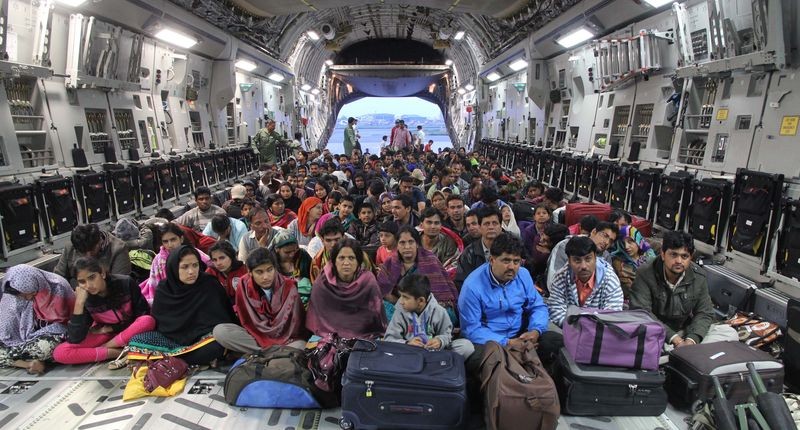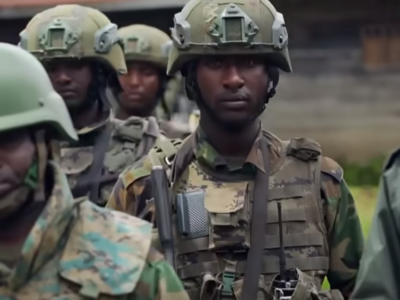
Nepalese victims of April 25, 2015 earthquake pictured inside an Indian Airforce aircraft as they are evacuated from Trishuli Bazar to Kathmandu airport in Nepal. Image via hemantrawat1234. Copyright Demotix (28/4/2015)
Just after a week of the April 25 Nepal earthquake, the hashtag #GoHomeIndianMedia began trending on Twitter in India. While the Nepalis thanked India for the immediate help offered after the earthquake, the Indian media has been criticised largely in Nepal for its insensitive reporting.
Some thought that the relief work has been used as a public-relations opportunity for the Indian government.
Some Nepalis accusing Indian media of using quake to promote Modi. #GoHomeIndianMedia trends: http://t.co/XSMvj9zTED pic.twitter.com/y5IPLqdbat
— Shreeya Sinha (@ShreeyaSinha) May 5, 2015
Others accuse the coverage itself of being insensitive and sensationalist. In one prominent example, an Indian reporter asks a Nepali mother crying uncontrollably over her dead child’s body, “How does it feel—what are your emotions right now?”
An indian news reporter to a mother who's learnt her only son has been buried under their house. Q. How do you feel? #GoHomeIndianMedia
— Prasanna KC (@KC_Prasanna) May 3, 2015
Times Now reporter asks an injured woman did someone of yours die? She says my 10 year old daughter. He asks her the same thing 6 times ??
— Ratna Vishwanathan (@ratnadv) April 26, 2015
Angered by the irresponsible reports in the Indian media, Nepalis online have started using the hashtag #GoHomeIndianMedia, which trended on Twitter for several days.
Have you seen the Chinese media interviewing anyone? Less talk and more work please. Respect is earned, not publicized #GoHomeIndianMedia
— Rubina (@RubinaKharel) May 3, 2015
The anger has expanded beyond social media, as well. An autorickshaw was seen advertising the hashtag in streets of Kathmandu, for instance.
If u got chance to travel around #Kathmandu in #Tempo then u'll see #GoHomeIndianMedia poster -Photo @aesmriti pic.twitter.com/oPJ1ALxr2F
— Prakash Timalsina (@prakashujyalo) May 5, 2015
Others say the Indian media has resorted to dirty gimmicks and showed a lack of basic humility in the earthquake's aftermath. This is not, incidentally, the first time India's reporters have faced such criticism. During the Uttarakhand flash floods, which killed over 5,000 people, some Indian media outlets saturated the airwaves with scenes of extreme grief, depicting flood victims at very vulnerable moments, which some critics said was closer to disaster exploitation than news reporting.
Some Indians have signaled online that they are ashamed of their own media's behavior.
#GoHomeIndianMedia @TimesNow @HeadlinesToday @mediacrooks and all Media Crooks out there feel shame on you pic.twitter.com/W74xDhTBLC
— Keerthivasan (@kvasan_c) May 4, 2015
Other Indians have started using the hashtag #DontComeBackIndianMedia.
This is the reason why #GoHomeIndianMedia is trending worldwide. Utterly shameful. So #DontComeBackIndianMedia pic.twitter.com/a3l243Pu5T
— SINGH (@Punjabi_AAPian) May 3, 2015
For some, like Krittivas Mukherjee, who published an op-ed in the Hindustan Times, much of the problem with Indian reporting in Nepal has to do with a “self-serving narrative” and “sense of condescension.”
Not everyone, of course, is eager to close the door on India's news media. Smita Sharma, a journalist based in New Delhi, wrote on Dailyo.in that naysayers should take a moment to consider if they're seeing the bigger picture:
It is time for course correction before #GoHomeIndianMedia hashtags overshadow all the good work done by many journalists, who too are mortals, and brave challenges to tell the world stories of those in pain.
While some grievances might lose perspective, general concerns about the Indian media do raise questions about its sensitivity, or lack thereof, in disaster situations. India has more than 100 news channels, and they all compete with one another in a fierce pursuit of “target rating points“. Every news channel wants to be the first on the ground and with an exclusive report. In the race to be first, especially during major disasters when so many people are tuning in, some media outlets fail to prioritize ethics and professional standards.
Others worry that networks are hiring too many amateurs, putting people in front of cameras before training them properly. Sunita Shakya, a writer of Nepalese origin, complained about this alleged trend in a blog post for CNN, where she compared the Indian media's reporting to soap operas.
Natural disasters present enormous ratings opportunities to the news media, but they can also fundamentally challenge the integrity of the press. The Indian media's struggles in Nepal are a fresh reminder of the difficulties in responding to mass suffering.







2 comments